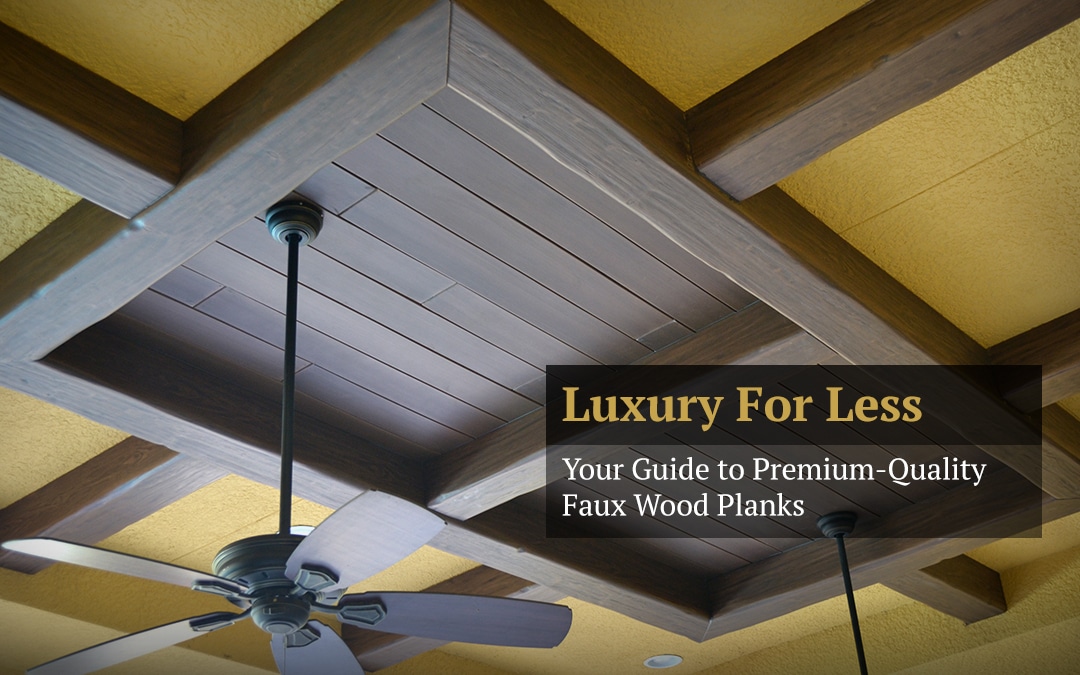Tags: Faux Wood, Faux Wood Beams, Faux Wood Beams for Ceiling, Faux Wood Ceiling Beams, Faux Wood Planks
Have you ever looked at wood floors and wished you could afford to put them in your home? Do you have Pinterest boards filled with pictures of sunlight falling dappled across stunning planks of oak or walnut? Does the expense and hassle of maintaining real wood stop you from having your dream home?
If any of this sounds familiar, faux wood planks could help you get the home of your dreams. Read on to learn more about these planks and why they’re a fantastic addition to your home.
What Are Faux Wood Planks?
Faux wood planks are a fantastic alternative to real wood. These planks are much more durable, affordable, and maintenance-free than traditional wood planking. It’s a great way for people who don’t want to spend an arm and a leg to get that luxurious look of genuine wood.
Faux wood is made from polyurethane foam and is finished to look just like real wood. But unlike real wood, these planks are impervious to moisture and temperature changes. There are a number of benefits of using faux wood planks over real wood which we’ll discuss later.
How Are They Made?
Every faux wood plank begins with the genuine article – the kind of wood you love to look at, but don’t want to pay for or maintain. Manufacturers take impressions of real wood planks to get their unique grain pattern, ridges, and whorls. They capture the uneven edges and special features that give real wood such character.
Once the foam has hardened, faux wood planks are painted to resemble genuine wood. This includes capturing variations in grain color, knots, and cracks. Finished planks will look like real wood so you can get the design you’ve always dreamed of without breaking the bank.
Benefits
One of the main benefits of faux wood planks is that they are much more affordable than real wood. Although up-front costs may be somewhat similar, you won’t have to spend as much on installation and maintenance.
When you’re installing real wood, you have to leave gaps to allow the planks to expand and contract as temperatures and humidity levels change. Faux wood planks are impervious to those changes, making installation much simpler.
Faux wood planks are also much lighter than real wood. If you’ve ever wanted to get that gorgeous wood look on your ceilings or walls, faux wood planks can allow you to do that without putting too much strain on the structures behind them.
How to Use Them
You can use faux wood planks in nearly any place you would use real wood planks. As we mentioned, they can make a great option for covering walls or ceilings. You can get that lovely air of rustic charm without worrying about the ceiling collapsing under the weight of a hundred genuine oak planks.
Many people also like to use faux wood planks for flooring. Their improved durability makes them an excellent choice for high-traffic areas or homes where kids and dogs may put some extra strain on the flooring. You can also use them in high-moisture areas like bathrooms or kitchens where you might normally worry about wood flooring buckling or warping.
Cost
Depending on the finish you choose, faux wood planks tend to run about $4 per square foot. This means if you’re finishing a room that’s 15’ x 20’, you’ll pay about $1,200 in material costs. Savvy readers will notice that this isn’t much different than the cost of a real wood floor, but just wait.
Getting a real wood floor installed can cost you anywhere from $600 to $800 or more, depending on the size of your room, the pattern you’re using, and the kind of wood you’re using. Then you’ll have to spend a few hundred dollars every five years or so getting your floors cleaned and refinished. Since you can install faux wood yourself and it requires no maintenance, your faux wood floors will have more than paid for themselves within the first ten years of your having them.
How to Install Them
Installing faux wood floors is a snap – in some cases, quite literally. Many faux wood planks use a tongue and groove design that seals each plank tightly against the next. You’ll begin by placing your first board in one corner of the room, tongue-side out, and driving nails through the face of the board to make sure it stays firmly in place.
With your first board placed, you’re going to place another board end-to-end with it, using a rubber mallet to gently tap it into place before nailing it down. Once you’ve got a full row in place, start back at the beginning of the row and lay a board edge-to-edge with the first line. Tap it into place, drive a nail at a 45-degree angle through the corner of the tongue, and continue on until your whole room is covered.
How to Maintain Them
One of the best things about faux wood floors is that you’ll never have to refinish them once they’re installed. You’ll just need to clean them in your normal routine. No sealing, no buckling floorboards, no rooms full of sawdust every few years while you get your floors refinished.
You will need to be careful what you use to clean your floors. Certain cleaning products can strip the finish off your faux wood planks, leaving them discolored and vulnerable to stains or wear. Only use cleaning products recommended by your faux wood manufacturer to avoid damage to your planks.
Find the Best Faux Wood Planks on the Market
Faux wood planks are a great way to get the elegance of wood flooring without all the hassle and expense. You can even use these planks or the walls or ceilings to get a charming rustic look. And with simple tongue and groove design, installation is simple enough that you can do it yourself on a weekend.
If you’d like to find the best faux wood planks on the market, check out the rest of our site at Diamond Resin Products. We have faux wood beams, tongue and groove planks, and more to remake your home. Shop our products today and discover for yourself how amazing faux wood beams can be.

